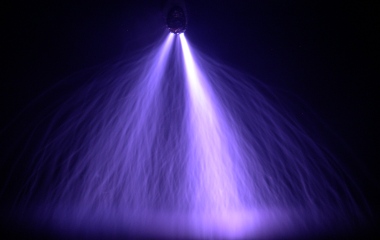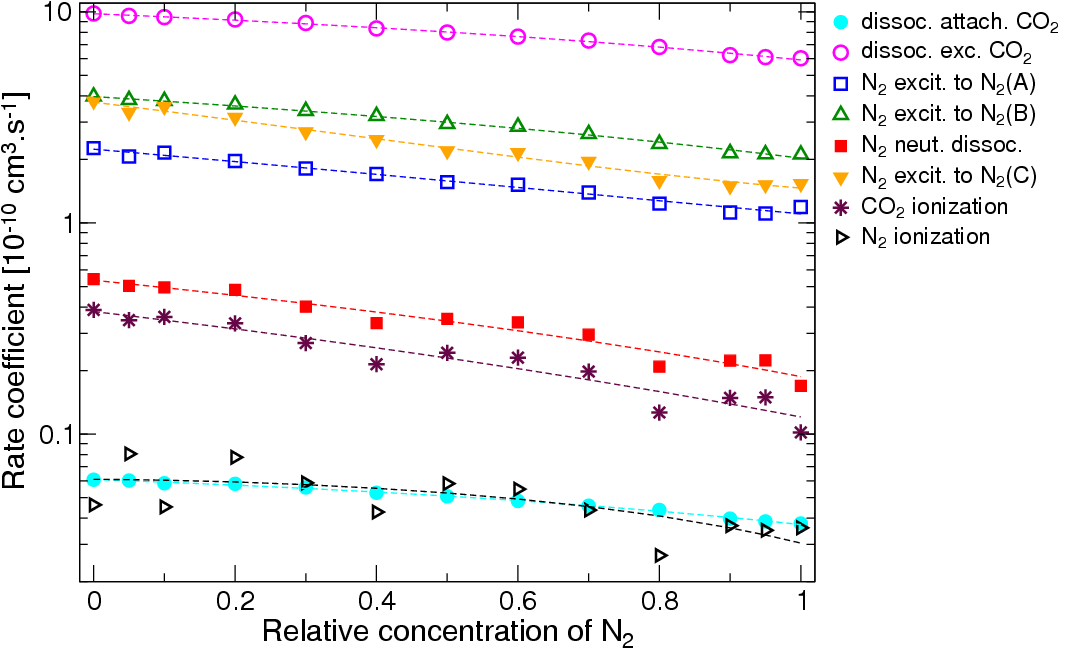Research

Research topics

1.1. Introduction
1.2. Diagnostic methods
1.3. Numerical modeling
1.4. DC glow discharge
1.5. Transient spark
1.6. Microwave plasma
1.7. Discharges in porous materials and capillaries
1.8. Discharges with water
2. Bio-medical plasma applications
3. Environmental plasma applications
4. Non-plasmatic environmental technologies
1.3. Numerical modeling
1.3.1. Monte Carlo simulations of electron dynamics
In Janda et al., Acta Physica Slovaca 55 (2005) 507-514, we present a free software for modeling the electron dynamics in the uniform electric field named Web-EEDF. It provides electron energy distribution function (EEDF), electron drift velocity, electron mobility, and collision frequency of electrons with neutrals as functions of reduced electric flied strength (E/N). EEDF (Fig. 1) enables us to calculate electron mean energy, electron mean free path, rate coefficients (Fig. 2) of electron-molecule collisional processes (e.g. excitation, attachment, ionization), and the branching of the electron energy towards these processes.
Calculated rate coefficients of electron-induced processes can facilitate better understanding of the importance of various reaction pathways leading to the decomposition of air pollutants in various gas mixtures. Despite its simplicity the Web-EEDF results are in good agreement with literature. It is also suitable for educational purposes by providing clearer insight in understanding physical and chemical mechanisms in plasma processes.
This electron dynamics modeling was further developed in Janda et al., Eur. J. Phys. D 45 (2007) 309-315. Motivated by the decomposition of CO2 and the synthesis of amino acids in DC electrical discharges, we investigated the electron dynamics by Monte Carlo simulations in N2/CO2 gas mixtures. The results of the simulations include electron mean energy, drift velocity, collision frequency of electrons with neutrals, mean free path of electrons, rate coefficients of selected electron-impact processes, and ionization and attachment coefficients as functions of the reduced electric field strength and the composition of a gas mixture. The knowledge of these parameters is crucial for the understanding of plasma induced chemistry and behavior of electrical discharges in such mixtures.
The applied computational method was proved useful for the calculation of steady-state EEDFs and derived parameters characterizing electrons in homogeneous electric fields in various gaseous mixtures. Web-EEDF source code can be downloaded from http://enviro.fmph.uniba.sk/web-eedf. We are currently developing new version which will enable to simulate time evolution of EEDFs, or the relaxation of electrons in electron beams.
More details in:
http://enviro.fmph.uniba.sk/web-eedf
| Janda M., Machala Z., Morvová M., Franček V., Lukáč P.: WEB-EEDF: Open Source Software for Modeling the Electron Dynamics, Acta Physica Slovaca 55, 507-514 (2005). abstract | download | citations: 0 |
| Janda M., Hensel K., Martišovitš V., Morvová M.: Theoretical study of influence of H2O on parameters of low-temperature plasmas in humid mixtures, Czech. J. Phys. 56, B774-B780 (2006). abstract | download | citations: 1 |
| Janda M., Martišovitš V., Morvová M., Machala Z., Hensel K.: Monte Carlo simulations of electron dynamics in N2/CO2 mixtures, Eur. Phys. J. D 45 (2), 309-315 (2007). abstract | download | citations: 15 |

